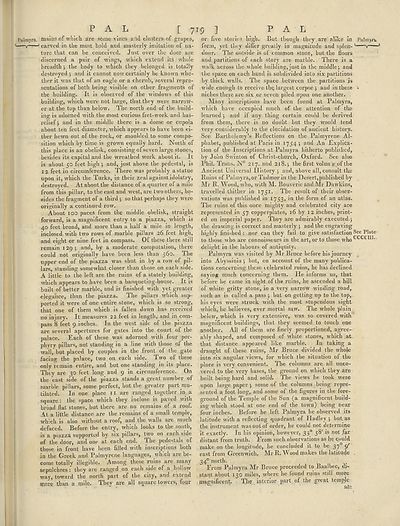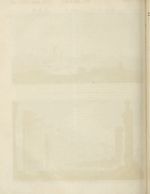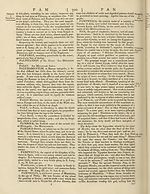Encyclopaedia Britannica > Volume 15, NIC-PAR
(797) Page 719
Download files
Complete book:
Individual page:
Thumbnail gallery: Grid view | List view

PAL [7
Palmyra, mains of which are some vines and clusters of grapes,
——v-" ' carved in the most bold and masterly imitation of na¬
ture that can be conceived. Just over the door are
discerned a pair of wings, which extend its whole
breadth ; the body to which they belonged is totally
destroyed •, and it cannot nowr certainly he known whe¬
ther it wras that of an eagle or a cherub, several repre¬
sentations of both being visible on other fragments of
the building. It is observed of the windows of this
building, which w'ere not large, that they were narrow¬
er at the top than below. The north end of the build¬
ing is adorned with the most curious fret-work and bas-
relief j and in the middle there is a dome or cupola
about ten feet diameter, which appears to have been ei¬
ther hewn out of the rock, or moulded to some compo¬
sition which by time is grown equally hard. North of
this place is an obelisk, consisting of seven large stones,
besides its capital and the wreathed work about it. It
is about 50 feet high ; and, just above the pedestal, is
12 feet in circumference. There was probably a statue
upon it, which the Turks, in their zeal against idolatry,
destroyed. At about the distance of a quarter of a mile
from this pillar, to the east and west, are two others, be¬
sides the fragment of a third 5 so that perhaps they w'ere
originally a continued row.
About xoo paces from the middle obelisk, straight
forward, is a magnificent entry to a piazza, which is
40 feet broad, and more than a half a mile in length,
inclosed with two rows of marble pillars 26 feet high,
and eight or nine feet in compass. Of these there still
remain 1295 and, by a moderate computation, there
could not originally have been less than 560. The
upper end of the piazza was shut in by a row of pil¬
lars, standing somewhat closer than those on each side.
A little to the left are the ruins of a stately building,
which appears to have been a banqueting-house. It is
built of better marble, and is finished with yet greater
elegance, than the piazza. The pillars which sup¬
ported it were of one entire stone, which is so strong,
that one of them which is fallen down has received
no injury. It measures 22 feet in length, and in com¬
pass 8 feet 9 inches. In the west side of the piazza
are several apertures for gates into the court of the
palace. Each of these was adorned with four por¬
phyry pillars, not standing in a line with those of the
wall, but placed by couples in the front ol the gate
facing the palace, two on each side. 1 wo of these
only remain entire, and but one standing in its place.
They are 30 feet long and 9 in circumference. On
the east side of the piazza stands a great number of
marble pillars, some perfect, but the greater part mu¬
tilated. In one place 1 x are ranged together in a
square : the space which they inclose is paved with
broad flat stones, but there are no remains of a roof.
At a little distance are the remains of a small temple,
which is also without a roof, and the walls are much
defaced. Before the entry, which looks to the south,
is a piazza supported by six pillars, two on each side
of the door, and one at each end. The pede-tals ot
those in front have been filled with inscriptions both
in the Greek and Palmyrene languages, which are be¬
come totally illegible. Among these ruins are many
sepulchres: they are ranged on each side of a hollow
way, toward the north part of the city, and extend
xtioi’C than a mile. T-hey ai-e all square towers, lour
9 ] PA L
or five stories high. But though they are alike in Pahnyn,
form, yet they differ greatly in magnitude and splen-y——
dour. The outside is of common stone, but the floors
and partitions of each story are marble. There is a
walk across the whole building, just in the middlej and
the space on each hand is subdivided into six partitions
by thick walls. The space between the partitions is
wide enough to receive thq largest corpse j and in these
niches there are six or seven piled upon one another.
Many inscriptions have been found at Palmyra,
which have occupied much of the attention of the
learned \ and if any thing certain could be derived
from them, there is no doubt but they would tend
very considerably to the elucidation of ancient history.
See Barthelemy’s Keflections on the Palmyrene Al¬
phabet, published at Paris in 1754 j and An Explica¬
tion of the Inscriptions at Palmyra hitherto published,
by John Swinton of Christ-church, Oxford. See also
Phil. Trans. N° 217. and 218.J the first volun e of the
Ancient Universal History ; and, above all, consult the
Ruins of Palmyra,or Tadmor in the Desert,published by
Mr R. Wood, who, with M. Bouveric and Mr Dawkins,
travelled thither in 1751. The result of their obser¬
vations was published in 1753, in the form of an atlas.
The ruins of this once mighty and celebrated city are
represented in 37 copperplates, 16 by 12 inches, print¬
ed on imperial paper. They are admirably executed.j
the drawing is correct and masterly $ and the engraving
highly finished : nor can they fail to give satisfaction See Plate
to those who are connoisseurs in the art, or to those who t
delight in the labours of antiquity.
Palmyra was visited by Mr Bruce before his journey
into Abyssinia j but, on account of the many publica¬
tions concerning these celebrated ruins, he has declined
saying much concerning them. He informs us, that
before he came in sight of the ruins, he ascended a hill
of white gi itty stone, in a very nari’ow winding road,
such as is called a pass ; but on getting up to the top,
his eyes were struck with the most stupendous sight
which, he believes, ever mortal saw. The whole plain
below, which is very extensive, was so covered with
magnificent buildings, that they seemed to touch one
another. All of them are finely proportioned, agree¬
ably shaped, and composed of white stones, which at-
that distance appeared like marble. In taking a
draught of these ruins, Mr Bruce divided the whole
into six angular views, for which the situation of the
place is very convenient. The columns are all unco¬
vered to the very bases, the ground on which they are
built being hard and solid. The views he took were
upon large paper j some of the columns being repre¬
sented a foot long, and some of the figures in the lore-
ground of the Temple of the Sun (a magnificent build¬
ing which stood at one end of the town) being near
four inches. Before he left Palmyra he observed its
latitude with a reflecting quadrant of Hadley $ but, as
the instrument was out of order, he could not determine
it exactly. In his opinion, however, 330 58' is not far
distant from truth. From such observations as he could,
make on the longitude, he concluded it to be 370 9'
east from Greenwich. Mr R. Wood makes the latitude ,
340 north.
From Palmyra Mr Bruce proceeded to Baalbec, di¬
stant about 130 miles, where he found ruins still more
magnificent. The interior part of the great temple
* ‘ ‘ ' at?
Palmyra, mains of which are some vines and clusters of grapes,
——v-" ' carved in the most bold and masterly imitation of na¬
ture that can be conceived. Just over the door are
discerned a pair of wings, which extend its whole
breadth ; the body to which they belonged is totally
destroyed •, and it cannot nowr certainly he known whe¬
ther it wras that of an eagle or a cherub, several repre¬
sentations of both being visible on other fragments of
the building. It is observed of the windows of this
building, which w'ere not large, that they were narrow¬
er at the top than below. The north end of the build¬
ing is adorned with the most curious fret-work and bas-
relief j and in the middle there is a dome or cupola
about ten feet diameter, which appears to have been ei¬
ther hewn out of the rock, or moulded to some compo¬
sition which by time is grown equally hard. North of
this place is an obelisk, consisting of seven large stones,
besides its capital and the wreathed work about it. It
is about 50 feet high ; and, just above the pedestal, is
12 feet in circumference. There was probably a statue
upon it, which the Turks, in their zeal against idolatry,
destroyed. At about the distance of a quarter of a mile
from this pillar, to the east and west, are two others, be¬
sides the fragment of a third 5 so that perhaps they w'ere
originally a continued row.
About xoo paces from the middle obelisk, straight
forward, is a magnificent entry to a piazza, which is
40 feet broad, and more than a half a mile in length,
inclosed with two rows of marble pillars 26 feet high,
and eight or nine feet in compass. Of these there still
remain 1295 and, by a moderate computation, there
could not originally have been less than 560. The
upper end of the piazza was shut in by a row of pil¬
lars, standing somewhat closer than those on each side.
A little to the left are the ruins of a stately building,
which appears to have been a banqueting-house. It is
built of better marble, and is finished with yet greater
elegance, than the piazza. The pillars which sup¬
ported it were of one entire stone, which is so strong,
that one of them which is fallen down has received
no injury. It measures 22 feet in length, and in com¬
pass 8 feet 9 inches. In the west side of the piazza
are several apertures for gates into the court of the
palace. Each of these was adorned with four por¬
phyry pillars, not standing in a line with those of the
wall, but placed by couples in the front ol the gate
facing the palace, two on each side. 1 wo of these
only remain entire, and but one standing in its place.
They are 30 feet long and 9 in circumference. On
the east side of the piazza stands a great number of
marble pillars, some perfect, but the greater part mu¬
tilated. In one place 1 x are ranged together in a
square : the space which they inclose is paved with
broad flat stones, but there are no remains of a roof.
At a little distance are the remains of a small temple,
which is also without a roof, and the walls are much
defaced. Before the entry, which looks to the south,
is a piazza supported by six pillars, two on each side
of the door, and one at each end. The pede-tals ot
those in front have been filled with inscriptions both
in the Greek and Palmyrene languages, which are be¬
come totally illegible. Among these ruins are many
sepulchres: they are ranged on each side of a hollow
way, toward the north part of the city, and extend
xtioi’C than a mile. T-hey ai-e all square towers, lour
9 ] PA L
or five stories high. But though they are alike in Pahnyn,
form, yet they differ greatly in magnitude and splen-y——
dour. The outside is of common stone, but the floors
and partitions of each story are marble. There is a
walk across the whole building, just in the middlej and
the space on each hand is subdivided into six partitions
by thick walls. The space between the partitions is
wide enough to receive thq largest corpse j and in these
niches there are six or seven piled upon one another.
Many inscriptions have been found at Palmyra,
which have occupied much of the attention of the
learned \ and if any thing certain could be derived
from them, there is no doubt but they would tend
very considerably to the elucidation of ancient history.
See Barthelemy’s Keflections on the Palmyrene Al¬
phabet, published at Paris in 1754 j and An Explica¬
tion of the Inscriptions at Palmyra hitherto published,
by John Swinton of Christ-church, Oxford. See also
Phil. Trans. N° 217. and 218.J the first volun e of the
Ancient Universal History ; and, above all, consult the
Ruins of Palmyra,or Tadmor in the Desert,published by
Mr R. Wood, who, with M. Bouveric and Mr Dawkins,
travelled thither in 1751. The result of their obser¬
vations was published in 1753, in the form of an atlas.
The ruins of this once mighty and celebrated city are
represented in 37 copperplates, 16 by 12 inches, print¬
ed on imperial paper. They are admirably executed.j
the drawing is correct and masterly $ and the engraving
highly finished : nor can they fail to give satisfaction See Plate
to those who are connoisseurs in the art, or to those who t
delight in the labours of antiquity.
Palmyra was visited by Mr Bruce before his journey
into Abyssinia j but, on account of the many publica¬
tions concerning these celebrated ruins, he has declined
saying much concerning them. He informs us, that
before he came in sight of the ruins, he ascended a hill
of white gi itty stone, in a very nari’ow winding road,
such as is called a pass ; but on getting up to the top,
his eyes were struck with the most stupendous sight
which, he believes, ever mortal saw. The whole plain
below, which is very extensive, was so covered with
magnificent buildings, that they seemed to touch one
another. All of them are finely proportioned, agree¬
ably shaped, and composed of white stones, which at-
that distance appeared like marble. In taking a
draught of these ruins, Mr Bruce divided the whole
into six angular views, for which the situation of the
place is very convenient. The columns are all unco¬
vered to the very bases, the ground on which they are
built being hard and solid. The views he took were
upon large paper j some of the columns being repre¬
sented a foot long, and some of the figures in the lore-
ground of the Temple of the Sun (a magnificent build¬
ing which stood at one end of the town) being near
four inches. Before he left Palmyra he observed its
latitude with a reflecting quadrant of Hadley $ but, as
the instrument was out of order, he could not determine
it exactly. In his opinion, however, 330 58' is not far
distant from truth. From such observations as he could,
make on the longitude, he concluded it to be 370 9'
east from Greenwich. Mr R. Wood makes the latitude ,
340 north.
From Palmyra Mr Bruce proceeded to Baalbec, di¬
stant about 130 miles, where he found ruins still more
magnificent. The interior part of the great temple
* ‘ ‘ ' at?
Set display mode to:
![]() Universal Viewer |
Universal Viewer | ![]() Mirador |
Large image | Transcription
Mirador |
Large image | Transcription
Images and transcriptions on this page, including medium image downloads, may be used under the Creative Commons Attribution 4.0 International Licence unless otherwise stated. ![]()
| Encyclopaedia Britannica > Encyclopaedia Britannica > Volume 15, NIC-PAR > (797) Page 719 |
|---|
| Permanent URL | https://digital.nls.uk/192592059 |
|---|
| Attribution and copyright: |
|
|---|
| Shelfmark | EB.11 |
|---|---|
| Description | Ten editions of 'Encyclopaedia Britannica', issued from 1768-1903, in 231 volumes. Originally issued in 100 weekly parts (3 volumes) between 1768 and 1771 by publishers: Colin Macfarquhar and Andrew Bell (Edinburgh); editor: William Smellie: engraver: Andrew Bell. Expanded editions in the 19th century featured more volumes and contributions from leading experts in their fields. Managed and published in Edinburgh up to the 9th edition (25 volumes, from 1875-1889); the 10th edition (1902-1903) re-issued the 9th edition, with 11 supplementary volumes. |
|---|---|
| Additional NLS resources: |
|

